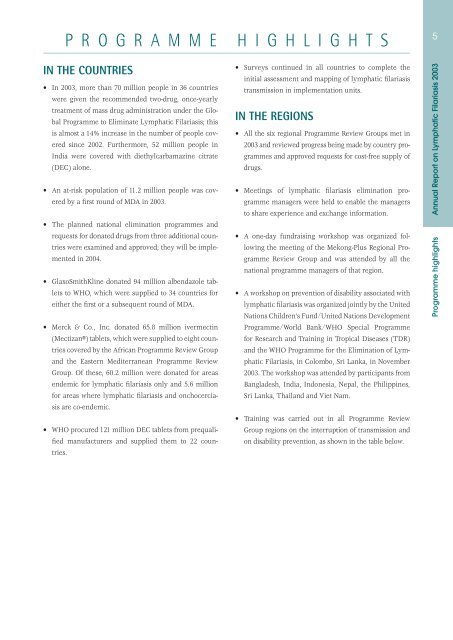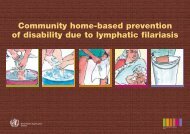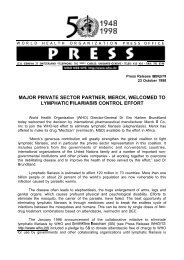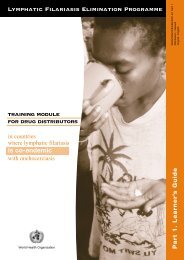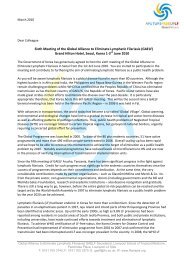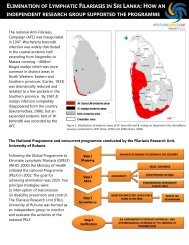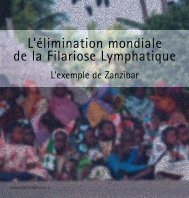Global Programme to Eliminate Lymphatic Filariasis ... - libdoc.who.int
Global Programme to Eliminate Lymphatic Filariasis ... - libdoc.who.int
Global Programme to Eliminate Lymphatic Filariasis ... - libdoc.who.int
Create successful ePaper yourself
Turn your PDF publications into a flip-book with our unique Google optimized e-Paper software.
P R O G R A M M E H I G H L I G H T S5IN THE COUNTRIES• In 2003, more than 70 million people in 36 countrieswere given the recommended two-drug, once-yearlytreatment of mass drug administration under the <strong>Global</strong><strong>Programme</strong> <strong>to</strong> <strong>Eliminate</strong> <strong>Lymphatic</strong> <strong>Filariasis</strong>; thisis almost a 14% increase in the number of people coveredsince 2002. Furthermore, 52 million people inIndia were covered with diethylcarbamazine citrate(DEC) alone.• An at-risk population of 11.2 million people was coveredby a first round of MDA in 2003.• The planned national elimination programmes andrequests for donated drugs from three additional countrieswere examined and approved; they will be implementedin 2004.• GlaxoSmithKline donated 94 million albendazole tablets<strong>to</strong> WHO, which were supplied <strong>to</strong> 34 countries foreither the first or a subsequent round of MDA.• Merck & Co., Inc. donated 65.8 million ivermectin(Mectizan®) tablets, which were supplied <strong>to</strong> eight countriescovered by the African <strong>Programme</strong> Review Groupand the Eastern Mediterranean <strong>Programme</strong> ReviewGroup. Of these, 60.2 million were donated for areasendemic for lymphatic filariasis only and 5.6 millionfor areas where lymphatic filariasis and onchocerciasisare co-endemic.• WHO procured 121 million DEC tablets from prequalifiedmanufacturers and supplied them <strong>to</strong> 22 countries.• Surveys continued in all countries <strong>to</strong> complete theinitial assessment and mapping of lymphatic filariasistransmission in implementation units.IN THE REGIONS• All the six regional <strong>Programme</strong> Review Groups met in2003 and reviewed progress being made by country programmesand approved requests for cost-free supply ofdrugs.• Meetings of lymphatic filariasis elimination programmemanagers were held <strong>to</strong> enable the managers<strong>to</strong> share experience and exchange information.• A one-day fundraising workshop was organized followingthe meeting of the Mekong-Plus Regional <strong>Programme</strong>Review Group and was attended by all thenational programme managers of that region.• A workshop on prevention of disability associated withlymphatic filariasis was organized jo<strong>int</strong>ly by the UnitedNations Children’s Fund/United Nations Development<strong>Programme</strong>/World Bank/WHO Special <strong>Programme</strong>for Research and Training in Tropical Diseases (TDR)and the WHO <strong>Programme</strong> for the Elimination of <strong>Lymphatic</strong><strong>Filariasis</strong>, in Colombo, Sri Lanka, in November2003. The workshop was attended by participants fromBangladesh, India, Indonesia, Nepal, the Philippines,Sri Lanka, Thailand and Viet Nam.• Training was carried out in all <strong>Programme</strong> ReviewGroup regions on the <strong>int</strong>erruption of transmission andon disability prevention, as shown in the table below.Annual Report on <strong>Lymphatic</strong> <strong>Filariasis</strong> 2003<strong>Programme</strong> highlights


